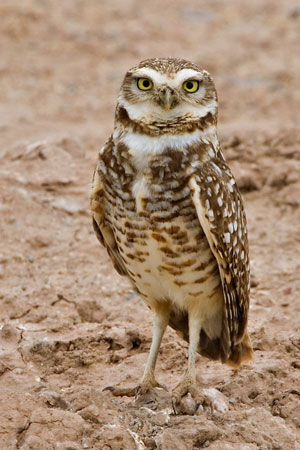

|
Burrowing Owl (Athene cunicularia) What they look like: Burrowing Owls are small brown long-legged owls that nest in burrows. They have short tails and no ear tufts. The eyes and bill are yellow. They are a diurnal bird - active both day and night. This is unlike others owls that are mainly active at night. 
Call: Song is a two-note coo coooo. Gives series of rattles clucks, and chatters. Listen to calls of this species » Where they live: The Burrowing Owl breeds from southern Alberta eastward to southern Manitoba, southward into Mexico. Also resident in Florida and into the Caribbean and throughout South America. They are found throughout the southern parts of eastern Washington. Click the range map to learn more about the distribution of Burrowing Owls in Washington. What they eat: Burrowing Owls are opportunistic feeders, preying on large invertebrates, small mammals, and other birds. 
Nesting: Burrowing Owls form monogamous pair bonds during the nesting season. Nest sites include rocky outcroppings, ground-squirrel burrows, drainage pipes, and artificial burrows provided by wildlife.
Behavior: Burrowing Owls often live in loose colonies. The adults take turns standing guard near the nest burrows. They are active both day and night, especially during the breeding season. These owls hunt by swooping down from perches and surprising prey. They also capture prey by hovering over open areas or by running along the ground to chase prey down. These small raptors catch prey with their talons. They are quick and can even snatch flying insects from mid-air. The Burrowing Owl collects mammal dung and puts it in and around its burrow. The animal waste attracts dung beetles, which the owl then captures and eats. Did you know?
More information: Animal silhouettes available to purchase » Photos: Natures Pics
|